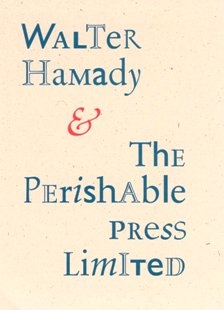February 19 - April 26, 2003
Walter Hamady & The Perishable Press Limited:
A Retrospective Exhibition (1964-2002)
Curated by Robert Bertholf
Organized by Dr. Robert Bertholf, Curator of the Poetry and Rare Books Collection at the State University of New York, Buffalo,
Walter Hamady & The Perishable Press Ltd surveys the output of this unique private press. Founded in 1964 by Walter S. Hamady, the Press has produced a wide-ranging series of titles including poetry by Paul Blackburn, Robert Creeley, and Lawrence Ferlinghetti, illustrated by artists such as Sam Gilliam, Ellen Lanyon and John Digby, in forms that defy categorization. Noted for their fine hand-made paper, distinguished typography, and unique colophons, the Perishable Press challenges traditional notions of the book. Hamady has said that the name of the Press "reflects the human condition which is both perishable and limited," yet its creativity indeed seems limitless.
Papermaker, printer, artist, poet, photographer, teacher and publisher of handmade books, Walter Hamady established his Perishable Press Limited in Mount Horeb, Wisconsin in 1964. As an undergraduate, Hamady had become interested in the relationship between poetry and the visual arts, and his first printed works-such as Robert Creeley's
Words (1965), Robert Duncan's
Six Prose Pieces (1966) and his collaboration with Aris Koutroulis on
Consenting Shadows (1966)-combined the two.
Meanwhile, Hamady had begun to craft fine handmade papers at the Cranbrook Academy of Arts, eventually developing his own "Shadwell" paper: an artisanal, textured sheet in many hues, named for Thomas Jefferson's birthplace. These were incorporated into works such as
Ephemeral Genesis & difficult meanderings in the quest of that that is called grand Paradise (1965) and
Six Poems and Pictures (1965) as well as
The Plumfoot Poems: A Summer Sequence (1966). These works brought together distinctive aspects of Perishable Press production: fine presswork, distinctive handmade papers, collaboration with binder Elizabeth Kner, and a combination of the Palatino and Michelangelo types (always hand-set) designed by Hermann Zapf for Stempel.
Over the years, the Press has produced a body of work highly sought after by collectors, books prized for their meticulous and complex physical structures, quirky colophons and inventive collaborations between typesetter, binder and illustrator. Joseph Blumenthal noted that Hamady's "craftsmanship is nothing short of brilliant, especially in the sometimes witty and playful ephemera." Hamady himself describes the book as "a living, dynamic possibility-a meeting place for whole worlds of divergent elements of human expression to melt and flow, to meld into excess beyond the limit of its parts. It is not merely bound pages to be sold and shelved and checked out."
The exhibition will be accompanied by a checklist, available for sale at the Grolier Club.